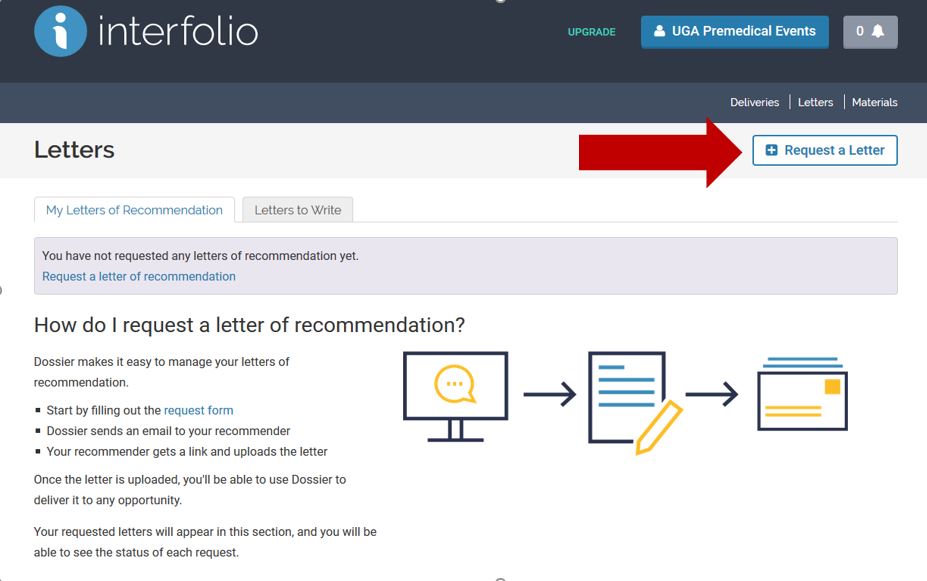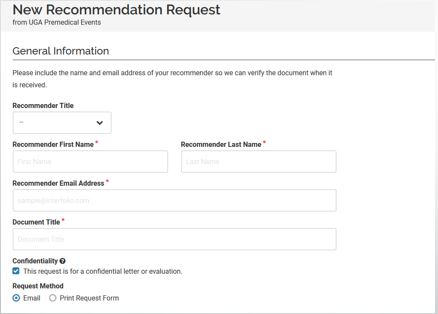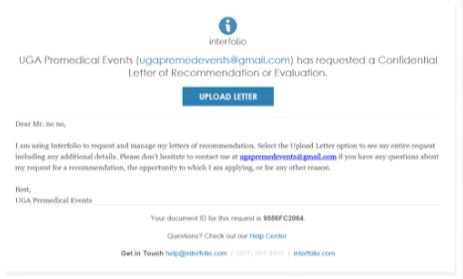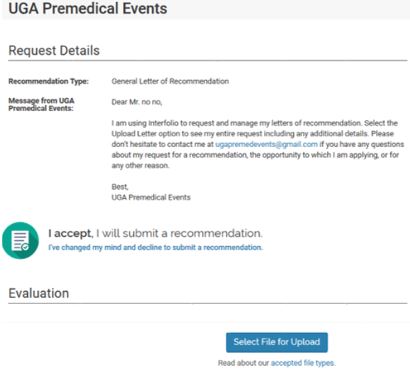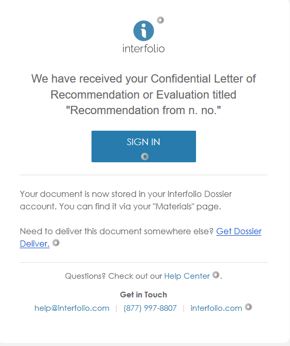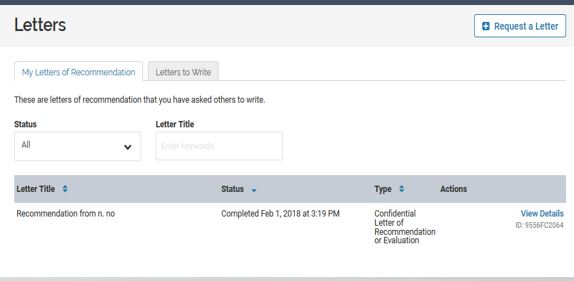Letters of Evaluation
Letters of Evaluation are an important portion of the medical school application. You should familiarize yourself with the types of letters of evaluation each medical school requires well before you head into the application cycle.
As of January 2016, the Pre-Professional Advising Office no longer serves as a repository/submission service for letters of evaluation to medical school. The absence of a "committee" or "pre-medical" letter will not adversely affect your application.
Letter Options
Most medical schools will provide you with several options for submitting letters of evaluation. Typically, you may submit one of the following:
- A minimum of three letters of recommendation from individuals (at least two from science faculty)
- A packet of letters from a Career Center or a Letter Writing Service
- A composite or committee letter from a Pre-Medical or Pre-Health Committee
UGA does not provide committee letters nor do we assemble letter packets. Instead, you will need to assemble a minimum of three individual letters for submission.
Note: Always waive your right to view your letters of evaluation.
Most medical schools require a minimum of 3 letters, but the AMCAS application allows you to submit up to 10. You are not required or necessarily expected to have 10 letters; schools often have their own specific letter caps. For example: Medical College of Georgia accepts up to 7 letters, but Mercer allows 6, Emory allows 5, and Morehouse only 3.
In practice, most applicants have 4-6 letters, and there is such a thing as too many letters. It is more important that you have strong, substantive letters than it is for you to have the maximum number of letters. This does not mean that you cannot collect the maximum if you know you can get 10 strong letters. In the AMCAS application, you can assign different letters to different schools. This means that if you do have 10 letters and a school only accepts 5, you can choose which 5 to send to that specific school.
If you have more letters than a particular school would prefer to receive, you will need to decide which letters you will send. First, it is important that you meet that school's letter requirements— i.e. if they ask for two science letters, be sure to include those. Next, evaluate which of your remaining letters are likely to be the strongest; you should not be sending lukewarm or redundant letters. It may also be beneficial to take into account a school's mission so you can select letters that help align you with their goals and convey that you would be a good fit.
The AACOMAS application allows up to 6 letters, and 3 is the recommended minimum. Unlike with the AMCAS application, you cannot assign different letters to different schools, so you must make sure you choose your 6 letters wisely.
Individual medical schools are quite specific in the number and types of letters of evaluation they expect from applicants. Therefore, you should be selective in who you ask to submit letters on your behalf and you should always double-check the individual requirements of each school to which you want to apply. Remember that while you do want to make sure that you are satisfying the requirements of the schools to which you are applying, it is equally critical that you obtain letters from evaluators who know you well and can speak positively on your behalf.
You should obtain two letters from science faculty. Research mentor letters will
often count for this requirement, but you still need to check with individual schools.
For example, LSU has very strict requirements and will not accept a research letter for this category,
but Emory has more flexible requirements and will. While LSU's policy is more of an exception than the norm, it does highlight why it
is important to always check each individual school's requirements. Further, you are
always encouraged to build relationships with multiple faculty members since they
can serve not only as mentors, but also as advocates.
If you have done research, you should always plan to include a letter from your research mentor. If you are in a hard science lab, this letter will likely be one of your core science letters as mentioned above. However, letters from research mentors in other areas, such as psychology or sociology, are extremely valuable as well and you should include them. Research mentors often have a chance to get to know their students well making this one of your strongest letters.
In addition to the science letters, you should obtain a letter from a physician with whom you have shadowed or volunteered. While this letter is not always explictly required, it is almost always expected. If you are applying to D.O. programs, you are highly encouraged to get a letter from a D.O. if possible.
There are some medical schools that require a non-science faculty letter, so make sure you cultivate relationships with non-science faculty as well since you may opt to apply to one of those programs, e.g. Harvard. Beyond that, you can include additional letters from other professors you may have worked closely with (for instance, as part of your double-major, minor, or certificate program), other physicians or healthcare professionals you have shadowed under or worked with, volunteer coordinators, etc.
You should NOT use personal references such as friends or family nor should you use professional references from evaluators who do not know you — e.g. a professor from a large lecture class who you have never spoken to, a senator that you have never worked with, your pastor, etc.
When asking for a letter of evaluation, it is important that you do so in person. Emailing or calling to set up a meeting or appointment is acceptable but you should request the letter face to face. Further, you should schedule an appointment with each of your evaluators by early Spring (no later than April) of the year you wish to apply to medical school. Your evaluator will need time to work on your letter, so be courteous and respectful. Do not forget that they are likely receiving requests from other students as well.
Due to the size of UGA, it can be difficult to generate 3 to 5 strong letters from college faculty and staff who know you very well and can offer significant insight into your character traits and capacity for entering the profession of medicine. Therefore, it is important that you not only work actively to build relationships from early on, but also that you provide your evaluators with as much information as possible when you do request a letter:
- Recent copy of your resume (with picture)
- Detailed instructions for how to submit the letter (AMCAS/AACOMAS or Interfolio)
- Brief statement of your educational goals
- Rough draft of your personal statement (if available)
- Guidelines for how to write a letter of evaluation
Using Interfolio (recommended)
We encourage you to consider using Interfolio to collect and submit your letters of evaluation. Interfolio's primary purpose is letter storage, so you can begin collecting letters before the application cycle opens. You can set up an Interfolio account for free to begin storing documents. However, in order to transmit your letters to the application service (AMCAS or AACOMAS), you must pay to upgrade to Dossier Delivery for a flat rate of $48 per year. Your letters will be maintained even if your delivery account expires and you can renew your account any time.
- How to use Interfolio:
Using AMCAS
If you do not opt to use Interfolio to store your letters, your evaluators will need to upload the letters directly to AMCAS. To do so, you must provide each of your letter writers with the AMCAS Letter Request Form. Keep in mind that the Letter Request Form does not become available until the AMCAS application opens (early May). Do not attempt to generate a form early (i.e. from the previous year's application) as your letters will not be correctly matched to your application.
Your evaluators will use the information on the form to either upload your letter directly into the AMCAS Letter Writer portal or to mail your letter.
Using AACOMAS
If you do not opt to use Interfolio to store your letters, your evaluators will need to upload the letters directly to AACOMAS. When the application opens in early May, you will be able to add new evaluators in the "Supporting Information" section of the application. Be sure that all of the information that you enter about the evaluator is accurate and that you include the correct email address for that person. Once you complete an entry, AACOMAS will send an email to your evaluator with an upload link for their letter. It is your responsibility to make sure that your evaluator is expecting this email. (Don't forget to have your evaluator check their spam folder since the email sometimes gets filtered out!)
Re-Applicant Letter Packet Procedures
If you are re-applying to a professional school and the Pre-Professional Advising Office previously uploaded a letter packet for you, the office will re-submit the letter packet for you upon request, if no changes or updates to the original letter packet have occurred. The Pre-Professional Advising Office will only maintain student files for previous applicants (letter packets) for 5 years; after which they are destroyed.
If you are requesting updated letters or changes to your original letter packet, please
email ptolbert@uga.edu, so Ms. Pamela Tolbert can return them to your faculty and staff letter writers.
Please note: Revised letters must be submitted directly to AMCAS, AACOMAS, or professional
schools by the letter writers.
Using the Pre-Professional Advising Office to Submit Letter Packet to AMCAS
You will email ptolbert@uga.edu your request to have your letter packet sent, you will need to include the AMCAS Letter request form (available in your AMCAS application). In AMCAS, you will list Pamela Tolbert, (Business Manager) as the contact person and select the "Letter Packet" option.
Using the Pre-Professional Advising Office to Submit Letter Packet to AACOMAS
If you are applying to Osteopathic medical schools; you will email ptolbert@uga.edu with your request. In addition, you will need to send a letter of recommendation request to ptolbert@uga.edu from the letters of recommendation section in AACOMAS. You will select the "Non-Committee Letter" option.
Using Interfolio to Submit Letter Packet
Please be aware that Interfolio (an online letter of recommendation document management service) is also an available option for your letter packet submission.
If you choose to have Interfolio submit your letters, you will submit a letter of recommendation request via Interfolio to ptolbert@uga.edu. This will ensure the fastest delivery to Interfolio. With an established Interfolio account, you can direct that your letter packet be submitted to AMCAS, ACCOMAS, or another application service or school for a delivery fee.
Interfolio is a paid service that will store your letters indefinitely and allow you to upload them to the following application systems: AMCAS, AACOMAS, AADSAS, and TMDSAS.
As soon as you create an account, you can enter letter writer information and they will receive an e-mail from Interfolio with a link to the upload page.
Begin by clicking on the "Request a Letter" link.
You will be prompted to fill out some information about your new recommendation request. This includes information about the recommender and will allow you to add a due date for the letter. You have the option to include a message for the recommender, and you can also upload your CV/Resume and any additonal documents you would like to provide.
Once you have completed the forms and clicked "Send Request," your letter writer will receive an email with an upload link.
When your letter writer clicks the link in the email, they will be taken to Interfolio's website and will be able to see the details of the request and upload the letter.
You should always waive your right to view any letters of recommendation, including those uploaded to Interfolio. As a result, when letters are uploaded, you will receive a notification that the letter is stored in Interfolio, but you will not be able to open the file and read the letter.
Once your letters are in Interfolio you can follow their step-by-step guide for how to upload letters to your application system.

